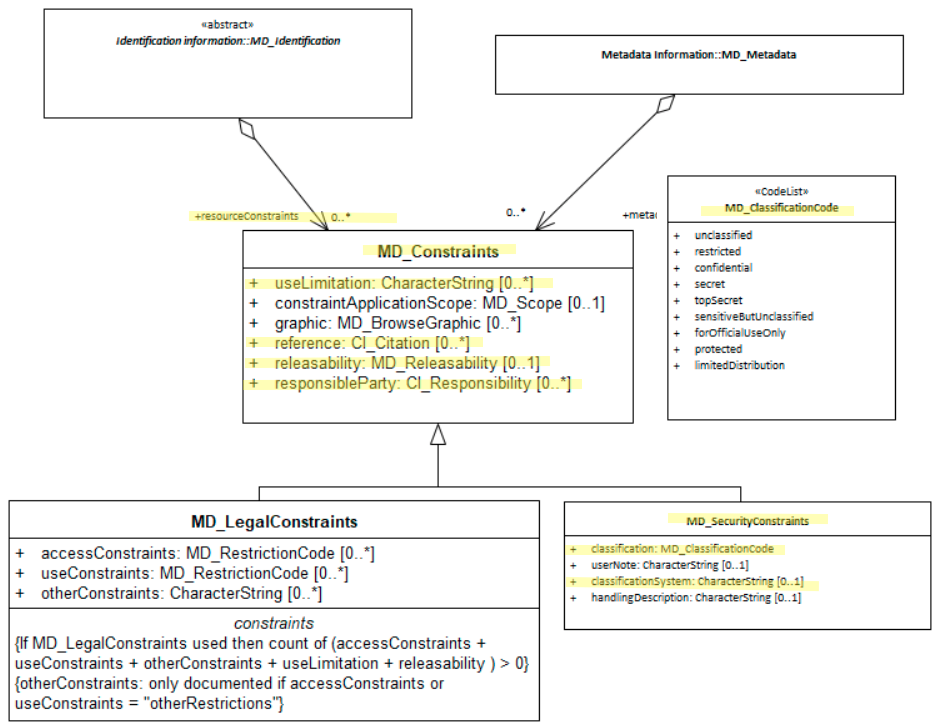Resource Security Constraints ★★★★★
When constraints (MD_Constraints) on a spatial resource [MD_Identification] concern security it is important to document these. Potential users need to be informed of the presence or absence of concerns about security that apply to the use of such resources.
| Element Name | resourceConstraints |
| Parent | MD_Metadata.identificationInfo>MD_Identification.resourceConstraints |
| Class/Type | MD_SecurityConstraints |
| Governance | Common ICSM, Agency, Domain |
| Purpose | Discovery, Identification |
| Audience | machine resource - ⭑ |
| general - ⭑ ⭑ ⭑ ⭑ ⭑ | |
| resource manager - ⭑ ⭑ ⭑ ⭑ | |
| specialist - ⭑ ⭑ ⭑ | |
| Metadata type | administrative |
| ICSM Level of Agreement | ⭑ ⭑ ⭑ |
Definition
Handling restrictions imposed on this cited resource for national security or similar concerns e.g. commercial sensitivity, privacy considerations.
ISO Obligation
- There should be zero to many [0..*] security related resourceConstraints recorded for the cited resource in the MD_DataIdentification or SV_ServiceIdentification package of class MD_SecurityConstraints in a metadata record.
Discussion
Many spatial resources carry some security restrictions regarding their access and use, such as national security, financial or commercial sensitivity, or privacy concerns as is common with census data. These security restrictions need to be documented for users and resource managers along with the identity of the applier of these constraints. Each agency needs to develop consistent guidance on the use of such a statement and share a clear understanding of its meaning. This is often done by reference to an external body that manages the definitions of the security constraints applied.
Outstanding Issues
Australian security classification codes The official codes used in Australia as mandated by Australian Protective Security Policy Framework, differ from those in the MD_RestrictionCode codelist. How to address using codes other than those supplied by
MD_RestrictionCodeneeds to be discussed. For interoperability, should we include theMD_RestrictionCodeas well as the PSPF?
Other security frameworks support There will be cases where other security frameworks and classification systems need to be cited, such as for New Zealand Defence. Instructions for how to include these are needed. Should such guidance be prescriptive or general?
ICSM Best Practice Recommendations
Therefore - it is important to capture all security constraints that apply to a spatial resource. If there be none it may be useful to capture such, particularly if your organisation does regularly handle sensitive resources. Agencies should develop consistent guidance on the use of security classifications and share a clear understanding of their meaning with users.
The MDWG recommends populating resourceConstraints with security constraint information to a sufficient level to determine the security structures and restrictions on a cited resource.
At a minimum, the name (primary and alternate) and version by which this security restriction on the access and use of this cited resource is known should be captured along with the classification value selected from the codelist - MD_RestrictionCode, or the codelist mandated by your agency, e.g. Australian Protective Security Policy Framework
Recommended Sub-Elements
- useLimitation - (type - charstr) [0..*] when a limitation(s) affecting the fitness for use of the resource is of a security nature.
- classification - (codelist - MD_RestrictionCode [0..*] name of the handling restrictions on the resource
- userNote - (type - charstr) 0 to 1 - explanation of the application of the legal constraints or other restrictions and legal prerequisites for obtaining and using the resource or metadata. Use when needed
- classificationSystem - (type - charstr) 0 to 1 - name of the classification system. Use when needed
-
handlingDescription - (type - charstr) 0 to 1 - additional information about the restrictions on handling the resource or metadata. Use when needed
- See guidance provided in MD_Constraints for the following elements:
- reference - (class - CI_Citation) [0..*] can be used to cite the Protective Security Policy Framework
- releasability - (class - MD_Releasability) [0..*] use when some parties have special considerations for use or access of the cited resource
- responsibleParty - (class CI_Responsibility) [0..*] contact information for those responsible for managing the security of the cited resource.
Also Consider
- Metadata Security Constraints contains security restriction information that apply to the metadata that cites the resource.
- Resource Legal Constraints A sibling to resource security constraints. Contains information regarding any legal restriction on the use or access of the resource.
- Other Constraints other constraints that apply to the access and use of a cited resource
Crosswalk considerations
Examples
XML
<mdb:MD_Metadata>
....
<mdb:identificationInfo>
<mri:MD_DataIdentification>
....
<mri:resourceConstraints>
<mco:MD_LegalConstraints>
<mco:useLimitation>
<gco:CharacterString>Not to be used for navigation
</gco:CharacterString>
</mco:useLimitation>
<mco:reference>
<cit:CI_Citation>
<cit:title>
<gco:CharacterString>
“Creative Commons Attribution 4.0 International
Licence”
</gco:CharacterString>
</cit:title>
<cit:citedResponsibleParty>
<cit:CI_Responsibility>
<cit:role>
<cit:CI_RoleCode
codeList="https://schemas.isotc211.org/19115
/resources/Codelist/cat/codelists.xml#CI_RoleCode"
codeListValue="rightsHolder"/>
</cit:role>
<cit:party>
<cit:CI_Organisation>
<cit:name>
<gco:CharacterString>OpenWork Ltd
</gco:CharacterString>
</cit:name>
<cit:contactInfo>
<cit:CI_Contact>
<cit:address>
<cit:CI_Address>
<cit:electronicMailAddress>
<gco:CharacterString>
info@openwork.nz
</gco:CharacterString>
</cit:electronicMailAddress>
</cit:CI_Address>
</cit:address>
</cit:CI_Contact>
</cit:contactInfo>
</cit:CI_Organisation>
</cit:party>
</cit:CI_Responsibility>
</cit:citedResponsibleParty>
</cit:CI_Citation>
</mco:reference>
<mco:accessConstraints>
<mco:MD_RestrictionCode
codeListValue="copyright"
codeList="https://schemas.isotc211.org/19115/resources
/Codelist/cat/codelists.xml#MD_RestrictionCode"/>
</mco:accessConstraints>
<mco:useConstraints>
<mco:MD_RestrictionCode
codeListValue="otherRestrictions"
codeList="https://schemas.isotc211.org/19115/resources
/Codelist/cat/codelists.xml#MD_RestrictionCode"/>
</mco:useConstraints>
<mco:otherConstraints>
<gco:CharacterString>For non-commercial purposes only
</gco:CharacterString>
</mco:otherConstraints>
</mco:MD_LegalConstraints>
</mri:resourceConstraints>
....
</mri:MD_DataIdentification>
</mdb:identificationInfo>
....
</mdb:MD_Metadata>
\pagebreak
UML diagrams
Recommended elements highlighted in yellow

\pagebreak
 ISO19115-1 Metadata Best Practice Guide
ISO19115-1 Metadata Best Practice Guide